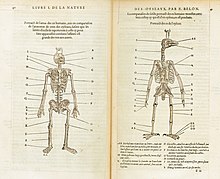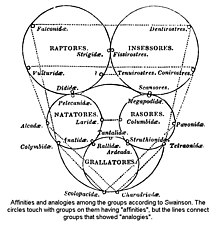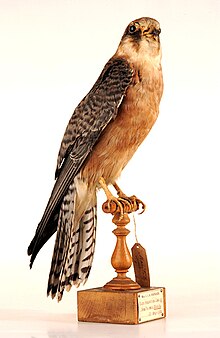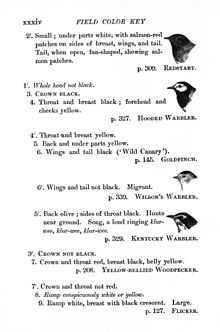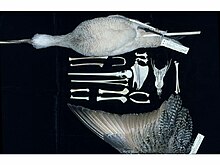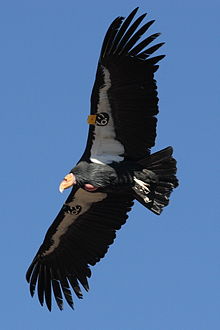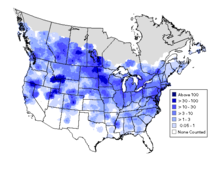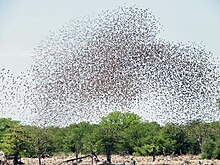Ornithology
Ornithology (from the Greek ὄρνις - ὄρνιθος, ornis - ornithos 'bird' and λόγος logos 'study', 'science') is the branch of zoology that deals with the study of birds. Many aspects of ornithology differ from related disciplines, due in part to the high sighting and aesthetic appeal of the birds. One of the most notable differences is the importance and number of studies carried out by hobbyists working within the parameters. of scientific methodology.
The science of ornithology has a long history, and the study of birds has helped develop many key concepts in evolution, behavior, and ecology, such as species; speciation processes; instinct; learning; ecological niche; island biogeography; phylogeography; and conservation.
While in its early days ornithology was primarily concerned with the description and distribution of species, today's ornithologists seek answers to very specific questions, often using birds as models to test hypotheses or predictions based on theories. Most modern biological theories apply indifferently across taxonomic groups, and therefore the number of professional scientists who identify themselves as ornithologists has dwindled. The range of tools and techniques used in ornithology is vast, and innovations are constantly being made.
History
The history of ornithology largely reflects trends in the history of biology. These tendencies include the movement from mere descriptions to the identification of patterns, and later towards the study of the processes that produce those patterns.
First studies
Humans have watched birds since the beginning of time; some Stone Age drawings are among the oldest signs of man's interest in birds. At this time birds were perhaps an important source of food, and the bones of as many as eighty species have been found in excavations of Stone Age settlements.
Cultures around the world have rich vocabularies referring to birds. Traditional names for birds are often based on detailed knowledge of their behaviour, with many names being onomatopoeic, and many others still in use. Lore may also involve the use of birds in traditional medicine, and knowledge of these practices is passed down as oral tradition. The hunting of wild birds, as well as their domestication, must also have required considerable knowledge of their habits.. Poultry keeping and falconry have been practiced since ancient times in many parts of the world. Artificial incubation of poultry was practiced in China around 246 BC. C. and in Egypt around 400 B.C. The Egyptians also represented birds in their hieroglyphs, many of which, although simplified, allow identification of the species.
The earliest written records provide valuable information about the ancient distributions of species. For example, Xenophon's writings mention the abundance of ostriches in Assyria; this Asia Minor subspecies is extinct, and the ostrich's distribution restricted to Africa. Other ancient writings contain careful and detailed descriptions of the life of birds, such as the Vedas (1500-800 BC) where the first reference to laying parasitism by the koel is included. scolopacea (Eudynamys scolopacea). precise illustrations of different species.
Aristotle in 350 B.C. C. in his work Historia Animalium he wrote about the migration habits of birds, their moulting, incubation and duration of their lives. He, however, introduced and propagated numerous myths, such as the idea that swallows hibernated even though he had noticed common cranes migrating from the Scythian steppes to the mouth of the Nile. to be so well established, that in 1878, Elliott Coues, could list up to 182 publications of that time that assumed the hibernation of swallows, while very few published evidence that contradicted the theory. Similar errors existed regarding to the breeding of the white-faced goose. Their nests had never been seen before and were thought to grow by transformation of crustaceans of the order Pedunculata, an idea that became commonplace around the century XI, and mentioned by Bishop Giraldus Cambrensis in his work Topographia Hiberniae (1187).
The origin of falconry can be found in Mesopotamia, with its first records dating back to the reign of Sargon II (722-705 BC). Falconry made its entry into Europe only after AD 400. C. through the invasions of Huns and Alans from the east. Frederick II of Germany (1194-1250) learned about Arab falconry during the wars in the region, and obtained an Arab treatise on falconry from Moamin. He managed to have this work translated into Latin and also carried out experiments on birds from his private collection of animals. Blinding some vultures and putting food nearby, he deduced that they found their food thanks to their sight and not by smell. He also developed methods for keeping and training falcons. The studies that he carried out for nearly 30 years were published in 1240 under the name De arte venandi cum avibus ("The art of hunting with birds"), a work that is considered one of the first studies on the behavior of birds.
Numerous German and French scholars compiled the old works and made new discoveries about birds. These include Guillaume Rondelet who wrote about his observations in the Mediterranean; and Pierre Belon who described the fish and birds that he had seen in France and the Mediterranean Levant. His work L & # 39; Histoire de la nature des oyseaux contains descriptions of nearly two hundred species. His comparison between the human and bird skeletons is considered a milestone in the evolution of comparative anatomy. Volcher Coiter (1534-1576), a Dutch anatomist, made detailed studies of the internal structure of birds and produced an classification of birds, De Differentiis Avium (circa 1572), which was based on criteria of structure and habits. Konrad Gesner wrote the works Vogelbuch and Icones avium omnium around 1557. Like Gesner, Ulisse Aldrovandi, a naturalist, published between 1599 and 1603 a 14-volume work on natural history, three of which were on birds. His Ornithologiae alone is over 2,000 pages long and includes such things as keeping chickens and other poultry. William Turner's Historia Avium (" A History of Birds") published in Cologne in 1544 was one of the earliest English ornithological works. He noted how frequent red kites were in English cities, where they would snatch food from children's hands. He treated popular beliefs such as that of fishermen who believed that ospreys destroyed their schools of fish, so they tried to kill them by mixing eagle meat into their baits.
In the 16th century Francis Willughby (1635-1672) and John Ray (1627-1705) made the first large bird classification systems based on their functions and morphology rather than their form or behavior. Willughby's Ornithologiae libri tres (1676) and completed by Ray, is sometimes considered the beginning of scientific ornithology. Ray also published another work, Ornithologia, which was published posthumously in 1713 under the name Synopsis methodica avium et piscium. The first list of English birds, Pinax Rerum Naturalium Britannicarum, was written by Christopher Merrett in 1667, yet to many (including Ray) it held little value.
Towards the end of the 18th century, Mathurin Jacques Brisson (1723-1806) and Georges Louis Leclerc (1707-1788)) carried out new works on birds. Brssion published a six-volume work, Ornithologie, in 1760 and Leclerc included nine volumes on birds (Histoire naturelle des oiseaux (1770-1785) in his work Histoire naturelle générale et particulière (1749-1804) Coenraad Jacob Temminck (1778-1858) sponsored François Le Vaillant (1753-1824) to collect bird specimens in Africa, which ultimately resulted in the publication of Histoire naturelle des oiseaux d'Afrique (1796-1808), six volumes by Le Vaillant. Louis Jean Pierre Vieillot (1748-1831) spent ten years studying North American birds and wrote the Histoire naturelle des oiseaux de l'Amerique septentrionale. Vieillot pioneered the use of natural history and habit in classification.
Scientific Studies
Ornithology emerged as a specialized science only in the Victorian era—with the proliferation of firearms, the concept of natural history, and collections of natural objects such as bird eggs and furs. This specialization gave rise to to the training in Great Britain of the British Ornithologists' Union in 1858. In 1859 the members formed their magazine The Ibis. The sudden surge in interest in ornithology was also due to colonization. One hundred years later, in 1959, R. E. Moreau noted that ornithology in this period was concerned with the geographic distributions of various bird species.
Undoubtedly the concern with widespread geographical ornithology was encouraged by the immensity of areas on which the British domain or its influence was extended during the century XIX and for some time later.Moreau
Victorian-era bird collectors noted variations in bird forms and habits across regions, noted local specialization, and variation in widely distributed species. Museum collections and private collectors grew with contributions from various parts of the world. The naming of species with the binomial system and the organization of birds into groups based on their similarities became the main work of museum specialists. Variations in widely distributed birds across geographic regions caused the introduction of trinominal names. The search for patterns in the variations of birds was attempted by many. Early ornithologists such as William Swainson followed the quinary system and this was replaced by more complex affinity "maps" in works by Hugh Edwin Strickland and Alfred Russel Wallace. The Galápagos finches are believed to have had a special influence on the development of Charles Darwin's theory of evolution. His contemporary Alfred Russel Wallace also noted these variations and the geographical separations between the different forms that gave rise to the study of biogeography. Wallace was influenced by the work of Philip Lutley Sclater on the distribution patterns of birds.
For Darwin, the problem was how species arose from a common ancestor, but he did not attempt to find delimitation rules for species. The problem of the species was addressed by the ornithologist Ernst Mayr. Mayr was able to show that geographic isolation and the accumulation of genetic differences led to the division of species.
Early ornithologists were concerned with issues of species identification. Only systematics was considered true science and field studies were considered inferior for much of the 19th century In 1901 Robert Ridgway wrote in the introduction to The Birds of North and Middle America that:
There are two essentially different types of ornithology: systematic or scientific, and popular. The first deals with the structure and classification of birds, their synonyms and technical descriptions. the second deals with habits, songs, nesting, and other facts pertaining to their natural stories.
This initial idea that the study of living birds was merely recreation remained dominant until ecological theories became the predominant focus of ornithological studies. The study of birds in Their habitats were particularly advanced in Germany with bird ringing stations established as early as 1903. By the 1920s the Journal für Ornithologie included many works on behaviour, ecology, anatomy and physiology, many writings by Erwin Stresemann. Stresemann. The editorial policy of the journal changed, aiming both at the unification of field and laboratory studies, and at a shift in the locus of research, from museums to universities. Ornithology in the United States continued to be dominated by studies museum of morphological variations, identity, and geographic distribution of species, until it was influenced by Stresemann's student Ernst Mayr. In Britain, some of the first ornithological work to use the word ecology appeared in 1915. The Ibis however resisted the introduction of these new study methods and published papers on ecology only in 1943. David Lack's work on population ecology was pioneering. Newer approaches to the study of ecology and behavior were introduced and these were not well accepted. For example, Claud Ticehurst wrote:
Sometimes it seems that the plans developed and statistics are made to prove what is a trivial knowledge for a simple collector, such as that hunting games often travel more or less in circles.Ticehurst
David Lack's studies on population ecology sought to find the process involved in population regulation based on the evolution of optimal clutch sizes. He concluded that the population was regulated primarily by density-dependent controls and also suggested that natural selection produces life history traits that maximize the fitness of individuals. Others, such as Wynne-Edwards, interpreted population regulation as a mechanism that helped the "species" rather than individuals. This led to a wide and sometimes acrimonious debate about what constituted the "unit of selection". Lack also pioneered the use of many new tools for ornithological research, including the idea of using radar to study bird migration.
Birds were also used in studies of the niche hypothesis and Georgii Gause's principle of competitive exclusion. Robert MacArthur did work on the partitioning of resources and the structuring of bird communities through competition. Biodiversity patterns also became a topic of interest. E. O. Wilson and Robert MacArthur pioneered work on the relationship of species numbers to area and its application to the study of island biogeography. These studies led to the development of the discipline of landscape ecology.
John Hurrell Crook studied the behavior of waterfowl and demonstrated the link between ecological conditions, behavior, and social systems. Principles of economics were introduced to the study of biology by J. L. Brown. This led to the study of behavior with the use of cost-benefit analysis. The growing interest in sociobiology also led to a surge of studies in this area. The study of imprinting behavior in ducks and geese by Konrad Lorenz and the studies of instincts in herring gulls by Nicolaas Tinbergen, led to the establishment of the field of ethology. The study of learning became an area of interest and the study of bird song has been a model for neuro-ethology studies. The role of hormones and physiology in controlling behavior has also been aided by birds as models. These birds have helped in the study of circadian and seasonal cycles. Migration studies have attempted to answer questions about the evolution of evolution, orientation, and navigation. The growth of genetics and the rise of molecular biology gave rise to the application of the gene-centered view of evolution to explain phenomena in birds. studies of family groups and altruism, such as that of helpers in the nest, became of particular interest. The idea of inclusive adaptation was used to interpret observations about behavior and life history, and birds were widely used models to test hypotheses based on theories postulated by W. D. Hamilton and others. The new tools of molecular biology changed the study of bird systematics. The systematics changed from being based on phenotype to being based on genotype. Charles Sibley and Jon Edward Ahlquist were pioneers in the use of techniques such as DNA-DNA hybridization applied to the study of evolutionary relationships, which resulted in what is called Sibley-Ahlquist taxonomy. This early technology has been superseded by newer ones based on nuclear and mitochondrial DNA sequence analysis and molecular phylogenetics approaches with cladistic statistical methods that make use of sequence alignment, construction of phylogenetic trees, and calibration of molecular clocks to infer evolutionary relationships.. Molecular techniques are also widely used in studies of population biology and ecology.
Rise to Popularity
The use of binoculars and telescopes for bird watching began in the 1820s and 1830s by pioneers such as J. Dovaston (who also pioneered the use of bird feeders), but it was not until 1880 that instruction manuals began to insist on the use of these tools.
Another major change was the growth in the publication of field guides for bird identification. The first guides were big and heavy; and were mainly focused on the identification of species in hand. One of the first new generation guides was produced by Florence Merriam in 1887, entitled Hints to Audubon Workers:Fifty Birds and How to Know Them. and how to know them).
The interest and popularity of birding grew in many parts of the world, and it was realized that there was an opportunity for hobbyists to contribute to professional biology. As early as 1916, Julian Huxley wrote an article in The Auk about the tensions between amateurs and professionals in the study of birds, and the possibility that amateurs could provide a large amount of data. to scientists.
Organizations were created in many countries, and they grew rapidly in number. Some of the most notable were the Royal Society for the Protection of Birds (RSPB) created in 1889 in the UK and the Audubon Society created in 1885 in the US. Although some of these organizations focus on conservation, others conduct studies major scientists, such as the creation of species distribution atlases.
Techniques
Ornithological instruments and techniques are varied and new inventions and approaches are quickly incorporated. Techniques can be broadly divided into the categories of those that are applicable to specimens and those that are used in the field, however the classification is approximate and many analytical techniques are usable in both the laboratory and the field or may require a combination of field and laboratory techniques.
Collection
The earliest approaches to the study of birds involved the collection of eggs, a practice known as oology. While collecting became a hobby for many hobbyists, the tags associated with these early egg collections lacked reliability for use in serious studies of bird reproduction. In order to preserve the eggs, a small hole was made in them and their content was extracted. This technique became standard with the invention of the blow drill around 1830. Egg collecting is no longer popular; however historical museum collections have been of value in determining the effects of pesticides such as DDT on physiology.
The use of bird skins to document species has long been a standard part of systematic ornithology. Bird skins are prepared by retaining the key bones of the wings, feet, and skull along with the skin and feathers. In the past, they were treated with arsenic to prevent attack by fungi and insects (mainly dermestids). The arsenic, being toxic, was replaced by borax. Sportsmen hobbyist collectors became familiar with these skin dissection techniques and began shipping their skins to museums, some from distant locations. This led to the formation of gigantic collections of bird skins in museums in Europe and North America. Many private collections were also formed. These became references for species comparison, and ornithologists in these museums were able to compare species from different localities, often from places they themselves had never visited. The morphometry of these skins, in particular the length of the tarsus, bill, tail and wing, became important in the descriptions of bird species. These fur collections have been used in more recent times for studies on molecular phylogenetics by extracting ancient DNA. The importance of type specimens in the description of species makes skin collections a vital resource for systematic ornithology. However, with the advent of molecular techniques, it has become possible to establish the taxonomic status of new discoveries, such as those of Laniarius liberatus (no longer a valid species) and Liocichla bugunorum, using blood, DNA and feather samples as holotype material. Other preservation methods include storing specimens in alcohol. Such moist specimens are of particular value in physiological and anatomical studies, apart from providing better quality DNA for molecular studies. Freeze-drying of specimens is another technique that has the advantage of preserving stomach contents and anatomy, although it tends to shrink the samples making them less reliable for morphometry.
In the field
The study of birds in the field was greatly aided by improvements in optics. Photography made it possible to document birds in the field with great precision. High-powered telephoto lenses today allow observers to detect minute morphological differences that previously could only be detected with the specimen in hand.
The capture and tagging of birds allows for detailed natural history studies. Techniques for catching birds are varied and include the use of bird garter (with sticky substances) for perching, Japanese netting for woodland birds, cannon netting for flocks in open areas, trap bal-chatri for raptors, the lure and funnel trap for waterfowl.
The bird in hand can be examined and measurements can be made including standard lengths and weights. Feather molt and skull ossification provide indications of age and health. Sex can be determined by examination of the anatomy in some species without sexual dimorphism. Blood samples can be drawn to determine hormonal conditions in physiology studies, identify DNA markers for genetic analysis, and family relationships in reproductive biology and phylogeography studies. Blood can also be used to find arthropod-borne pathogens and viruses. Ectoparasites can be collected for coevolutionary and zoonotic studies. In many cryptic species, measurements (such as the relative lengths of wing feathers in warblers) are vital to species identification.
Caught birds are often marked for later recognition. Rings or bands provide durable identification but require capture before the information they carry can be read. Field-identifiable markings such as color bands, wing tags, and paints allow for short-term studies where individual identification is required. The mark-recapture technique makes demographic studies possible. Banding has traditionally been used in migration studies. In recent times satellite transmitters provide the ability to track birds during migration in near real time. Techniques for estimating population density include point count, transect, and territorial mapping. Observations are made in the field using carefully designed protocols, and the data can be analyzed to estimate bird diversity, relative abundance, or absolute population density. These methods can be used repeatedly over long periods of time to monitor changes in the environment.. The photographic trap has been considered a useful tool in the detection and documentation of elusive species, nest predators, and in the quantitative analysis of frugivory, seed dispersal, and behavior.
In the laboratory
Many aspects of bird biology are difficult to study in the field. These include behavioral and physiological changes that require long-term access to the bird. Samples of blood or feathers taken without damage during field studies can be studied in the laboratory. For example, the variation in the hydrogen isotope ratio at different latitudes makes it possible to roughly establish the origin of migratory birds with the use of mass spectrometer analysis of feather samples. These techniques can be used in combination with other techniques such as the ringed. The first attenuated vaccine developed by Louis Pasteur was for fowl cholera and was tested in chickens in 1878. Chickens continue to be used as a model for many studies in non-mammalian animal immunology. Bird behavior studies include the use of tamed and captive-trained birds. Studies of bird intelligence and song learning have been largely laboratory-based. Field researchers make use of a wide range of techniques such as the use of mimic owls to elicit mobbing behaviour, male dolls or the use of call recordings to induce territorial behaviors and thus establish the boundaries of bird territories. Bird migration studies that include aspects of navigation, orientation, and physiology are often performed with captive birds in special cages to record their activities. Emlen's funnel, for example, uses a cage with inked pads in the center and a conical floor where the feet imprint marks that can be counted to identify the direction in which the bird intends to fly. The funnel can have a transparent roof and visual stimuli such as the direction of sunlight can be controlled using mirrors or the positions of the stars simulated in a planetarium. The complete genome of the domestic chicken (Gallus gallus) was sequenced in 2004 and then in 2008 the zebra finch (Taeniopygia guttata) genome was also sequenced. Whole genome sequencing allows the study of the evolutionary processes involved in speciation. Associations between gene expression and behavior can be studied using candidate genes. Variations in the exploratory behavior of the Greater Tit (Parus major) have been found to be linked to a gene orthologous to the human Drd4 gene (dopamine D4 receptor) which is known to be associated with the behavior of search for novelties. The role of gene expression in developmental differences and morphological variations have been studied in Darwin's finches. Differences in Bmp4 expression have been shown to be associated with changes in growth and beak shape. The chicken has long been a model organism for the study of developmental biology in vertebrates. Since the embryo is readily accessible, its development can be easily followed (unlike the mouse). This also allows the use of electroporation to study the effect of adding or silencing a gene. Other tools for perturbing your genetic makeup are embryonic stem cells and viral vectors.
Collaborative studies
With the growth of interest in birds, it has become possible to use large numbers of people to work on collaborative ornithology projects that cover wide geographic scales. These citizen science projects include national-wide projects such as in the United States the Christmas Bird Count, the Backyard Bird Count, the North American Breeding Bird Survey, the Canadian EPOQ, or regional projects such as the Asian Waterbird Census. These projects help to identify the distribution of birds, their population densities and changes over time, migration departure and arrival dates, reproductive seasonality, and even population genetics. Migration studies using bird banding birds or their color marking often involves the cooperation of people and organizations in different countries.
Applications
Wild birds are involved in many human activities while domestic birds are important as a source of eggs, meat, feathers and other products. Applied and economic ornithology aims to reduce the harmful effect of problematic birds and increase the use of beneficial species.
The role of some bird species as pests, particularly in agriculture, is well known. Granivorous birds such as queleas in Africa are among the most numerous birds in the world and feeding flocks can cause devastation. Many insectivorous birds are also prized as beneficial to agriculture. Many of the early studies of the benefits and harm caused by birds in fields were done by analyzing stomach contents and observing feeding behavior. Modern studies directed at the management of birds in relation to agriculture make use of a broad spectrum of principles of ecology. Intensive aquaculture has brought humans into conflict with fishing birds such as cormorants. Large flocks of pigeons and starlings in cities are often considered a nuisance and techniques are constantly being innovated to reduce their populations or their impacts. The birds are also of medical importance and their role as carriers has been widely recognized. of human diseases such as Japanese encephalitis, West Nile virus, and H5N1. Bird strikes and the damage they cause to aviation are of particularly great importance, due to the fatal consequences and the level of economic losses caused. It has been estimated that the airline business worldwide incurs damages of 1.2 billion each year. Many bird species have been driven to extinction by human activities. Bird conservation requires specialized knowledge in aspects of biology, ecology and may require the use of very locally specific approaches. Ornithologists contribute to conservation biology by studying the ecology of wild birds and identifying key threats and pathways to enhance species survival. Critically threatened species such as the California Condor have must have been captured and bred in captivity. Such ex situ conservation measures may later allow the reintroduction of the species to its natural environment.
Contenido relacionado
Ethology
Needle
Cell nucleus

